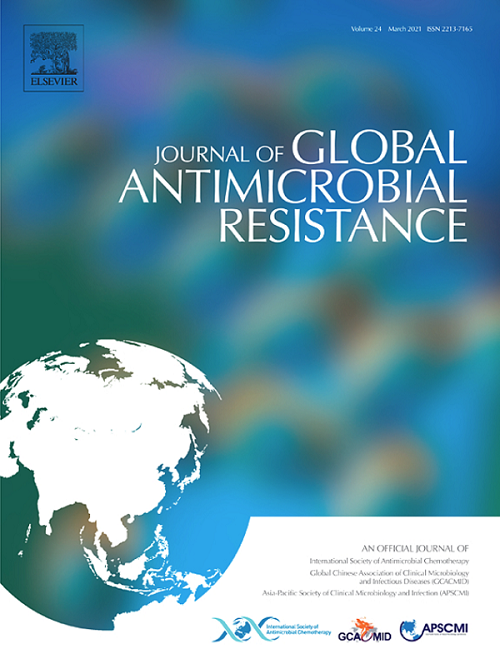首次报道多重耐药铜绿假单胞菌临床分离株中blaAFM-3和blaIMP-45基因染色体共现。
IF 3.2
3区 医学
Q2 INFECTIOUS DISEASES
引用次数: 0
摘要
背景:多药耐药(MDR)铜绿假单胞菌,特别是碳青霉烯酶产生菌株,由于其广泛传播和有限的治疗选择,构成了重大的临床挑战。病例与方法:一位65岁的颅内感染患者住院治疗。采用MALDI-TOF质谱法、抗菌药敏试验(AST)和全基因组测序(WGS)对从患者脑脊液中分离的一株耐多药铜绿假单胞菌进行分析。结果:铜绿假单胞菌YB1除对粘菌素耐药外,对碳青霉烯类、头孢菌素、喹诺酮类、氨基糖苷类均耐药。其基因组由一条6.41 mb的染色体和一个448 kb的incp样质粒组成。在染色体MDR区鉴定出6个β-内酰胺酶基因:blaPER-1、blaOXA-1、blaIMP-45和blaAFM-3, blaOXA-488和blaapo -201位于其外。染色体MDR区与质粒携带的Tn6485e具有高度同源性,其起源于多个质粒。具体来说,新的碳青霉烯酶基因blaAFM-3位于一个保守的转座子(ISCR27n3-groL-△flor -blaAFM-3- blemll - trpf - iscr27n2)中,与最初在粪Alcaligenes质粒中表征的基因相同。此外,blaIMP-45位于一个保守的I型整合子(IntI-aac(6')- ib -blaIMP-45- blaoxy -1- catb3 -△qacE-sul1)中。值得注意的是,在YB1的质粒上发现了染色体MDR区缺失的Tn6485e的3′端序列(IS26-aph(3′)-Ia-IS26-tet(C)-tetR(C)-IS26-IS6100)。此外,IS26位于覆盖MRD区域的71600 bp染色体片段的两侧,其外侧有一个14 bp的反向重复序列(5'-GGCACTGTTGCAAA-3'),其方向相同,这意味着IS26可能促进质粒染色体重组。结论:本研究首次在铜绿假单胞菌染色体上发现blaAFM-3和blaIMP-45基因共存。监测基因从质粒到染色体的转移是至关重要的,因为它提高了细菌对抗生素的存活率,并使遗传耐药性成为可能,威胁人类健康。本文章由计算机程序翻译,如有差异,请以英文原文为准。
First report of chromosomal co-occurrence of blaAFM-3 and blaIMP-45 genes in a multidrug-resistant Pseudomonas aeruginosa clinical isolate
Background
Multidrug-resistant (MDR) Pseudomonas aeruginosa, especially carbapenemase-producing strains, poses major clinical challenges due to their widespread dissemination and limited treatment options.
Case and Methods
A 65-y-old patient with intracranial infection was hospitalized. An MDR P. aeruginosa strain isolated from her cerebrospinal fluid was analysed using MALDI-TOF mass spectrometry, antimicrobial susceptibility testing, and whole genome sequencing.
Results
P. aeruginosa strain YB1 was resistant to carbapenems, cephalosporins, quinolones, and aminoglycosides, except colistin. Its genome comprised a 6.41-Mb chromosome and a 448-kb IncP-like plasmid. Six β-lactamase genes were identified on the chromosome: blaPER-1, blaOXA-1, blaIMP-45, and blaAFM-3 in the MDR region, with blaOXA-488 and blaPAO-201 located outside it. The chromosomal MDR region shared high homology with plasmid-borne Tn6485e, which originated from multiple plasmids. Specifically, the novel carbapenemase gene blaAFM-3 resided in a conserved transposon (ISCR27n3-groL-△floR-blaAFM-3-bleMBL-trpF-ISCR27n2), identical to that originally characterized in the Alcaligenes faecalis plasmid. Additionally, blaIMP-45 was located in a conserved type I integron (IntI-aac(6′)-Ib-blaIMP-45-blaOXY-1-catB3-△qacE-sul1). Notably, the 3′-terminal sequence of Tn6485e (IS26-aph(3′)-Ia-IS26-tet(C)-tetR(C)-IS26-IS6100), absent from the chromosomal MDR region, was found on YB1’s plasmid. Moreover, IS26 flanked the 71 600-bp chromosomal fragment covering the MRD region, with a 14-bp inverted repeat (5′-GGCACTGTTGCAAA-3′) on their outer sides in the same orientation, implying potential IS26-facilitated plasmid-chromosome recombination.
Conclusions
This study first identified the coexistence of the blaAFM-3 and blaIMP-45 genes on the chromosome of P. aeruginosa. Monitoring gene transfer from plasmids to chromosomes is crucial, as it boosts bacterial survival against antibiotics and enables heritable resistance, threatening human health.
求助全文
通过发布文献求助,成功后即可免费获取论文全文。
去求助
来源期刊

Journal of global antimicrobial resistance
INFECTIOUS DISEASES-PHARMACOLOGY & PHARMACY
CiteScore
8.70
自引率
2.20%
发文量
285
审稿时长
34 weeks
期刊介绍:
The Journal of Global Antimicrobial Resistance (JGAR) is a quarterly online journal run by an international Editorial Board that focuses on the global spread of antibiotic-resistant microbes.
JGAR is a dedicated journal for all professionals working in research, health care, the environment and animal infection control, aiming to track the resistance threat worldwide and provides a single voice devoted to antimicrobial resistance (AMR).
Featuring peer-reviewed and up to date research articles, reviews, short notes and hot topics JGAR covers the key topics related to antibacterial, antiviral, antifungal and antiparasitic resistance.
 求助内容:
求助内容: 应助结果提醒方式:
应助结果提醒方式:


